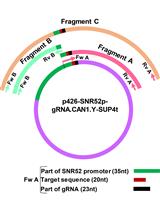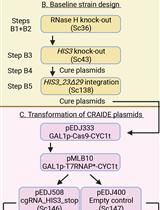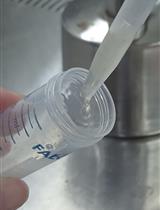- EN - English
- CN - 中文
CRISPR/Cas9 Ribonucleoprotein-Mediated Mutagenesis in Sporisorium reilianum
CRISPR/Cas9 核糖核蛋白介导的玉米丝轴黑粉菌诱变
发布: 2024年04月20日第14卷第8期 DOI: 10.21769/BioProtoc.4978 浏览次数: 2492
评审: Shweta PanchalEugenio LlorensXiaofei Liang
Abstract
Clustered regularly interspaced short palindromic repeats/CRISPR-associated protein 9 (CRISPR/Cas9) has become the state of the art for mutagenesis in filamentous fungi. Here, we describe a ribonucleoprotein complex (RNP)-mediated CRISPR/Cas9 for mutagenesis in Sporisorium reilianum. The efficiency of the method was tested in vitro with a cleavage assay as well as in vivo with a GFP-expressing S. reilianum strain. We applied this method to generate frameshift- and knock-out mutants in S. reilianum without a resistance marker by using an auto-replicating plasmid for selection. The RNP-mediated CRISPR/Cas9 increased the mutagenesis efficiency, can be applied for all kinds of mutations, and enables a marker-free genome editing in S. reilianum.
Key features
• First CRISPR/Cas9 application in S. reilianum.
• Generation of S. reilianum mutants without genomic integration of resistance marker.
• Allows the generation of multiple gene knockouts as well as deletion of large genomic regions.
Keywords: CRISPR/Cas9 (CRISPR/Cas9)Background
The smut fungi consist of more than 1,500 species, being highly economically important due to their infection of relevant crops such as barley, sorghum, wheat, and maize [1]. The majority of smut fungi infect their host systemically through the roots and replace the inflorescences with teliospores without causing symptoms during early infection stages [2,3]. One example of this systemic infection is Sporisorium reilianum f. sp. zeae, which is the causal agent of maize head smut. S. reilianum is closely related to the intensively investigated model organism Ustilago maydis. However, they differ in their mode of infection as well as in the site of symptom development [4,5]. In 2010, a genome sequence of S. reilianum f. sp. zeae was published, which, together with the U. maydis genome, provided the foundation for systematic identification and genetic manipulation of effector genes contributing to virulence [6,7]. Genome comparison of U. maydis and S. reilianum revealed conserved effector genes even though they differ drastically in their pathogenesis on the same host, Zea mays. To characterize effector genes and their contribution to virulence, knock-out mutants are generated and compared to the wild type. In the past, U. maydis knock-out mutants were generated using PCR-amplified donor templates with resistance markers for gene replacements [8]. Importantly, it was shown that not only the genomic locus but also the integration of resistance markers can negatively influence the expression of reintegrated genes [9]. Recently, the mutagenesis of U. maydis was drastically improved with a marker-free approach using clustered regularly interspaced short palindromic repeats/CRISPR-associated protein 9 (CRISPR/Cas9) [10,11] and further developed for a seamless gene conversion approach [12]. In contrast to U. maydis, the generation of knockout mutants in S. reilianum is still dependent on resistance markers, and multiple gene knockouts are hampered by the limited number (i.e., carboxine, hygromycin, nourseothricin, and phleomycin) of available resistance markers [8]. However, the plasmidbased CRISPR/Cas9 transformation as used in U. maydis has not been successful for S. reilianum.
CRISPR/Cas9, originating from the adaptive immune system of Streptococcus pyogenes, has been broadly adapted to many eukaryotic systems. It is a versatile tool for mutagenesis in various filamentous fungi [13]. The delivery strategies of CRISPR/Cas9 differ between fungal species: (i) stable genomic integration of cas9, (ii) transient delivery of Cas9 where the expression of Cas9 is dependent on selection pressure of a self-replicating plasmid or a telomere vector [10,14], or (iii) ribonucleoprotein complex (RNP)mediated transformation [15,14]. Here, we describe CRISPR/Cas9 applications in S. reilianum using an RNPmediated transformation approach. We demonstrate the generation of frameshifts as well as knock-out mutants mediated by RNPs, thereby generally improving the mutagenesis, and, for the first time, enable a marker-free editing in S. reilianum.
Materials and reagents
Biological materials
S. reilianum strains were stored at -80 °C in 30% glycerol. For transformation, S. reilianum wildtype strains SRZ1 and SRZ2 [7] were used.
Reagents
Single-guide RNA (sgRNA) synthesis
T4 DNA polymerase (New England Biolabs, catalog number: M0203S), storage: -20 °C
NEBufferTM r2.1 (50 mM NaCl, 10 mM Tris-HCl, 10 mM MgCl2, 100 μg/mL BSA, pH 7.9), storage: -20 °C (New England Biolabs, catalog number: B7202S)
dNTPs (DNA) (Carl Roth, catalog number: K039.1), storage: -20 °C
NucleoSpin® Gel and PCR clean up (Machery and Nagel, catalog number: 740.609.250), storage: RT
HiScribe® T7 High Yield RNA Synthesis kit (New England Biolabs, catalog number: E2040S), storage: -20 °C
DNase I (Thermo Fisher, catalog number: EN0521), storage: -20 °C
DNase I buffer (Thermo Fisher, catalog number: EN0521), storage: -20 °C
RNA Clean & Concentrator 25 kit (Zymo Research, catalog numbers: R1017 and R1018), storage: RT
Purple loading dye (New England Biolabs, catalog number: B7024S); ingredients: 2.5% Ficoll®-400, 10 mM EDTA, 0.08% SDS, 0.02% Dye 1, 0.02% Dye 2, pH 8; storage: RT
Nuclease-free water, storage: RT
Formation of RNP and in vitro cleavage assay
EnGen® Spy Cas9 NLS + NEB buffer r3.1 (New England Biolabs, catalog number: M0667)
500 mM Ethylenediaminetetraacetic acid (EDTA) (Carl Roth, catalog number: 8043.2)
Proteinase K (Thermo Fisher, catalog number: EO0491)
100 bp ladder (New England Biolabs, catalog number: N3231S)
Universal agarose (Bio-Budget, catalog number: 10-35-1020)
1% Ethidium bromide solution (Carl Roth, catalog number: 2218.2)
Potato dextrose agar (PDA) plates (39 g/L) (BD, DifcoTM, catalog number: 213400)
Tris base (Sigma, catalog number: 102262896)
Acetic acid (VWR, catalog number: 20103.330)
EDTA 0.5 M pH 8.0 (Carl Roth, catalog number: 8043.2)
Protoplasting and transformation of S. reilianum
Novozym 234 [Novo Nordisc; Denmark, not available anymore; alternative: lysing enzyme from Trichoderma harzianum (Sigma, catalog number: SLBJ0553V)]
Sodium citrate (Carl Roth, catalog number. 3580.1)
Sorbitol (Sigma, catalog number: 102466217)
Citrate acid (Carl Roth, catalog number: X863.2)
Sorbitol (Sigma, catalog number: 102466217)
Tris-HCl (Carl Roth, catalog number: 9090.3)
CaCl2 (Sigma, catalog number: 1002825086)
Poly(ethylene glycol) PEG MW3350 (Sigma, P4338, catalog number: 102604683)
BactoTM-Yeast-Extract (Thermo Fisher, Gibco, catalog number: 212720)
BactoTMPeptone (BD, Difco, catalog number: 211820)
Sucrose (Carl Roth, catalog number: 4621.2)
Sorbitol (Sigma, catalog number: 102466217)
BactoTM-Agar (BD, catalog number: 214030)
Potato dextrose agar (PDA) plates (BD, DifcoTM, catalog number: 213400)
Carboxine (5 mg/mL) (Sigma, catalog number: 102085144)
Heparin sodium salt from porcine intestinal mucosa (15 mg/mL) (Sigma, catalog number: 1001937695)
Solutions
50× TAE buffer (see Recipes)
1× TAE buffer (see Recipes)
SCS buffer (see Recipes)
STC buffer (see Recipes)
STC/40% PEG (see Recipes)
Regeneration agar light (see Recipes)
Recipes
50× TAE buffer
Reagent Final concentration Quantity or Volume Tris base 2 M (v/v) 242.0 g Acetic acid 2 M (v/v) 57.1 mL EDTA 0.5 M pH 8.0 10% (v/v) 100.0 mL 1× TAE buffer
Reagent Final concentration Quantity or Volume 50× TAE buffer 2% (v/v) 20.0 mL Deionized water 98% (v/v) 980.0 mL SCS buffer
Reagent Final concentration Quantity or Volume Solution 1: Sodium citrate, pH 5 0.6% (w/v) 5.9 ml Sorbitol 18.2% (w/v) 182.0 g Solution 2: Citrate acid 0.4% (w/v) 4.2 g Sorbitol 18.2% (w/v) 182.0 g Solution 1 and 2 are mixed until pH 5.8 is reached (ratio ~5:1) and autoclaved.
STC buffer
Reagent Final concentration Quantity or Volume Sorbitol 50% (v/v) 500.0 mL Tris-HCl, 1 M pH 7.5 1% (v/v) 5.0 mL CaCl2, 1 M, sterile-filtrated (100 mL total volume is enough) 10% (v/v) 50.0 mL STC/40% PEG
Reagent Final concentration Quantity or Volume STC buffer 60% (v/v) 600.0 mL Poly(ethylene glycol) PEG, MW3350; sterilefiltrated, (50 mL total volume is enough) 40% (w/v) 400.0 g Regeneration agar light
Reagent Final concentration Quantity or Volume BactoTM yeast extract 1% (w/v) 10.0 g BactoTM peptone 0.4% (w/v) 20.0 g Sucrose 0.4% (w/v) 20.0 g Sorbitol 18.2% (w/v) 182.2 g BactoTM agar 1.5% (w/v) 15.0 g
Laboratory supplies
PCR machine (Bio-Rad, model: T100TM Thermal Cycler)
Microfuge for PCR tubes (VWR, model: Ministar)
Tabletop centrifuge (VWR, model: Microstar 17)
37 °C incubator (Memmert, model: UN110)
28 °C incubator/room
Optional: Polyacrylamide gel electrophoresis (SDS-PAGE) equipment (Bio-Rad, model: PowerPacTM Basic, Mini-Protean® Tetra System)
Agarose gel electrophoresis equipment
Nanodrop (Thermo Scientific, model: Nanodrop 2000c)
ChemiDocTM MP imaging system (or equivalent imaging system), with GFP filter (Bio-Rad, model: Universal Hood III)
Geldoc: visualization of DNA by UV radiation using a gel documentation unit (Peqlab/VWR, model: EBOX VX5)
Equipment
PCR tubes and 1.5 ml Eppendorf tubes
Sterile cut tips (1,000 µL and 20 µL)
Procedure
文章信息
版权信息
© 2024 The Author(s); This is an open access article under the CC BY-NC license (https://creativecommons.org/licenses/by-nc/4.0/).
如何引用
Werner, J., Zuo, W. and Doehlemann, G. (2024). CRISPR/Cas9 Ribonucleoprotein-Mediated Mutagenesis in Sporisorium reilianum. Bio-protocol 14(8): e4978. DOI: 10.21769/BioProtoc.4978.
分类
微生物学 > 微生物遗传学 > CRISPR-Cas9
您对这篇实验方法有问题吗?
在此处发布您的问题,我们将邀请本文作者来回答。同时,我们会将您的问题发布到Bio-protocol Exchange,以便寻求社区成员的帮助。
Share
Bluesky
X
Copy link












